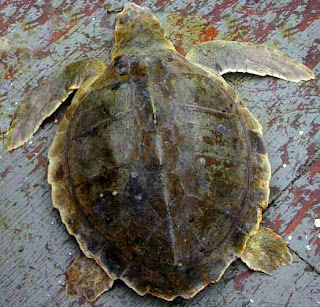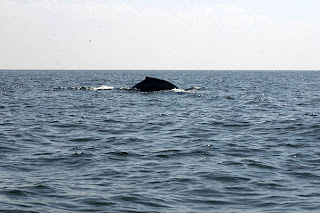
These highly endangered sea turtles were returned to their natural habitat at the end of Randolph Ave. beside the Cape Charles Beach Gazebo this morning at 11:00 AM.
Ten of the Kemp's ridleys came from the New England Aquarium. These turtles stranded in Cape Cod Bay in November and December, suffering from cold stunning, a condition that occurs when sea turtles are exposed to extremely cold water. Their patients names have a National Parks theme: Saguaro; Valley Forge; Yucca House; Buck Island Reef (the smallest turtle which came in at 2.16 lbs. and is now a whopping 4.41 lbs.; Lassen Volcanic; Ulysses S. Grant (nicknamed by volunteers as "the General"; Lowell (not named after Mike Lowell from the Red Sox); Pinnacles (the largest turtle who weighs 13.56 lbs.); Pecos; and Ellis Island.

Common symptoms associated with cold stunning are dehydration, lethargy, and starvation. According to New England Aquarium staff, Yucca House came in with an undetectable heart rates via their Doppler and had to have an ultrasound done to make sure the turtle was still alive. Both Lassen Volcanic and Lowell had severe pneumonia early on in the rehabilitation process and underwent nebulization therapy to help clear the lungs.
The "local" Kemps ridleys who rehabbed at the Virginia Aquarium Marine Animal Care Center are "Stormin Norman" and "Kalikimaka." Stormin' Norman stranded during the November 20, 2009, Nor'easter. He was cold-stunned with a few scratches and a head injury. According to Aquarium staff, Norman initially weighed 2.87 lbs. and he has "fattened-up to 8.71 lbs. while awaiting warmer waters for his release.

"Kalikimaka," named after the Hawaiian phrase "Mele Kalikimaka" meaning Merry Christmas, was found by a couple on Virginia Beachs Sandbridge Beach December 23, 2009. Kalikimaka was emaciated, cold-stunned, missing one rear flipper, and had severe trauma to both eyes. The Kemps ridley was treated with internal antibiotics as well as drops for its eyes. Kalikimaka has retained sight in both eyes and swims as if he had both
rear flippers. The Virginia Aquarium Stranding Response Program's mission is to promote the conservation of marine animal species through stranding response, research, rehabilitation and education. It is largely a volunteer-basedgroup operating from the Aquarium's Marine Animal Care Center in Virginia Beach. The program is supported by the Virginia Aquarium Foundation through donations from the community, and grant-making organizations.
To report a dead or live stranded marine mammal or sea turtle call the Virginia Aquarium Stranding Response Program 24-hour hotline at (757) 437-6159.


